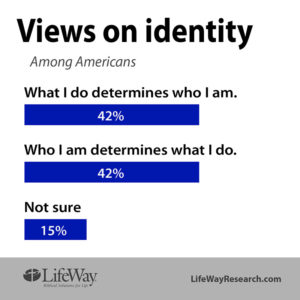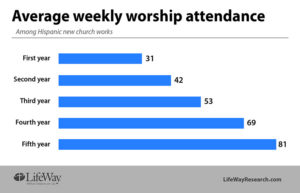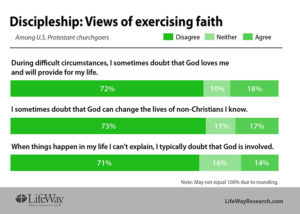NASHVILLE, Tenn.—Las nuevas plantaciones de las iglesias hispanas en los Estados Unidos ven patrones similares de crecimiento de asistencia y conversiones, como otras iglesias a pesar de tener una fracción del apoyo financiero y capacitación.
Incluso, el crecimiento también ocurre cuando las congregaciones enfrentan complicaciones adicionales por el estatus migratorio de los miembros y líderes.
LifeWay Research hizo una encuesta a líderes de más de 200 nuevas iglesias hispanas de 14 denominaciones protestantes y descubrió que la mayoría de los pastores y miembros nacieron fuera de los Estados Unidos.
Entre los pastores principales de estas iglesias, el 94 por ciento son hispanos y el 80 por ciento son inmigrantes de primera generación. Aproximadamente uno de cada 12 (8 por ciento) dice que él o ella nació en los Estados Unidos, pero uno o ambos padres nacieron en otro lugar, y el 12 por ciento dice que tanto ellos como sus padres nacieron en los Estados Unidos.
Un pastor de cada cuatro (25 por ciento) dice que algunos de los líderes de su iglesia tienen estatus indocumentado. Aproximadamente dos de cada tres (64 por ciento) dicen que ninguno de los líderes de su iglesia tiene estatus de indocumentado, y el 11 por ciento prefiere no responder.
Dentro de las iglesias, los pastores estiman que el 89 por ciento de su congregación es hispana o latina. Dos tercios (66 por ciento) nacieron fuera de los Estados Unidos, mientras que 22 por ciento son inmigrantes de segunda generación y 12 por ciento son tercera generación.
Los pastores dicen que la mayoría de sus congregaciones son ciudadanos con estatus legal permanente (68 por ciento), mientras que estiman que el 21 por ciento de los miembros de su iglesia tienen estatus indocumentado y 11 por ciento tienen estatus legal temporal.
Dos tercios de las nuevas obras de la iglesia hispana (64 por ciento) realizan sus servicios completamente en español. Y las tres cuartas partes (73 por ciento) dicen que no tienen planes de cambiar el idioma o los idiomas utilizados en su iglesia.
Las nuevas congregaciones hispanas son, en gran parte, de mediana edad, con un 40 por ciento de entre 30 y 49 años. Aproximadamente uno de cada cinco (21 por ciento) en la iglesia tiene menos de 18 años, 16 por ciento tiene entre 18 y 29 años, y 23 por ciento tiene 50 años o más.
“Aunque la mayoría de los líderes de estas iglesias son inmigrantes de primera generación, la mayoría han estado en el área donde su iglesia sirve durante 10 años o más”, dijo Scott McConnell, director ejecutivo de LifeWay Research.
Crecimiento similar con menos recursos
Al igual que con la mayoría de otras plantaciones de iglesias, las obras de nuevas iglesias hispanas ven un crecimiento exponencial durante los primeros años. El promedio de asistencia en el primer año de la iglesia es de 31. El número sube a 42 en el segundo año, 53 en el tercer año, 69 en el cuarto año y 81 después del quinto.
Aunque esos números son más pequeños que otras plantaciones de iglesia, tienen trayectorias de crecimiento similares. Un estudio similar de LifeWay Research de 2015 sobre 843 plantaciones de iglesias protestantes, encontró que el promedio de una nueva iglesia comenzó con 51 personas en asistencia semanal de culto y creció a 146 para el quinto año.
Lo mismo ocurre con el número de conversiones. En el primer año, los líderes de la iglesia hispana dicen que su iglesia vio 10 compromisos por primera vez con Jesús. Eso subió a 13 en el segundo año y 15 en los años tres y cuatro.
Entre todas las plantaciones de iglesias en el estudio de 2015, una iglesia promedio vio 11 conversiones en el primer año, 14 en el segundo, 18 en el tercero y 17 en el cuarto año.
Al igual que en todas las plantaciones de iglesias, alrededor de 4 de cada 10 asistentes a nuevas obras hispanas no pertenecen a ninguna iglesia o lo han estado durante muchos años. Sin embargo, las iglesias hispanas están alcanzando un porcentaje más alto de aquellos que están completamente sin iglesia (26 por ciento a 18 por ciento).
“Aunque las nuevas obras de la iglesia hispana comienzan siendo más pequeñas, son más eficaces para el evangelismo por persona,” dijo McConnell. |
Para comenzar su iglesia, el 60 por ciento de los pastores de nuevas obras hispanas dicen que recibieron fondos de su denominación, en comparación con el 72 por ciento de todas las plantaciones de iglesia.
Menos iglesias hispanas comienzan a decir que reciben fondos de una congregación patrocinadora (45 por ciento a 56 por ciento).
En total, los pastores hispanos que trabajan en nuevas iglesias dicen que reciben un promedio de menos de $ 13,000 en su primer año de fuentes externas, que se reduce a menos de $ 8,000 en el quinto año. En comparación, en general, las plantaciones de iglesias tienen un promedio de más de $ 43,000 de fondos externos en su primer año. Incluso en para su quinto año, la plantación promedio de iglesia recibe más dinero de otros ($ 15,409) de lo que el nuevo trabajo hispano recibe en su primer año.
De manera similar, las nuevas iglesias hispanas reciben, en promedio, $ 13,617 de los miembros de la iglesia y los asistentes en su primer año. Eso sube a $ 33,782 para el cuarto año, que es menos de lo que la plantación de la iglesia promedio recibe de los asistentes en su primer año ($ 46,191).
Menos de un tercio de las plantaciones de iglesias hispanas han recibido capacitación inicial de la iglesia que incorpora específicamente la dinámica de un contexto hispano / latino.
“Recaudar fondos de donantes individuales puede incluir desafíos interculturales,” dijo McConnell. “Pero no existe una justificación válida para las desigualdades de fondos que la iglesia hispana comienza a experimentar, especialmente a nivel denominacional.”
Entre el 61 por ciento de la iglesia hispana comienza con una iglesia patrocinadora, sin embargo, es más probable que todas las plantaciones de iglesias con una iglesia patrocinadora a decir que recibieron apoyo como usar un edificio de la iglesia, que el pastor de la iglesia patrocinadora predique ocasionalmente, ayudando con las necesidades administrativas y brindando capacitación.
Los pastores de nuevas obras hispanas tienen menos probabilidades de recibir capacitación de su denominación y menos probabilidades de tener una educación avanzada.
En general, entre los plantadores de iglesias, el 42 por ciento tiene un título universitario, mientras que el 6 por ciento tiene un diploma de escuela secundaria como máximo. Para los pastores de nuevas obras hispanas, el 24 por ciento tiene un título universitario y el 19 por ciento tiene un diploma de escuela secundaria o menos.
Los nuevos pastores hispanos pueden tener menos educación, pero tienden a tener más experiencia de vida.
La edad promedio de un nuevo pastor hispano de trabajo es de 49 años, mientras que más de un tercio (37 por ciento) tiene menos de 45 años. En general, entre los plantadores de iglesias, el 62 por ciento plantó antes de los 45 años, incluyendo el 31 por ciento de los que plantaron menores de 35 años.
“Hasta ahora, el desarrollo de jóvenes iniciadores de iglesias hispanas se está quedando muy por detrás de otras etnias. Y no se debe a la falta de jóvenes en la iglesia,” dijo McConnell.
Evangelismo y oración
Los nuevos pastores de trabajo hispanos superaron muchos de los déficits de recursos al poner un mayor énfasis en el evangelismo y la oración.
Dos tercios de los pastores de trabajo hispanos (67 por ciento) dicen que han seguido utilizando las visitas evangelísticas para identificar las perspectivas de la iglesia después de iniciar la iglesia, mientras que solo el 32 por ciento de las plantaciones de iglesias hacen lo mismo en general.
La mitad de las nuevas obras hispanas (52 por ciento) siguen utilizando el evangelismo puerta a puerta en comparación con el 22 por ciento de las plantaciones de iglesias en general.
Desde el comienzo de la iglesia, el 79 por ciento de las nuevas obras hispanas brindan capacitación evangelística para los miembros de la iglesia, mientras que el 50 por ciento de las plantaciones de iglesias hacen lo mismo en general.
Las obras hispanas también son más propensas a decir que tienen una reunión de oración semanal intencional para los miembros (78 por ciento a 53 por ciento).
“La efectividad del evangelismo hispano en el trabajo de la nueva iglesia está directamente vinculada a que estas iglesias están haciendo más alcance,” dijo McConnell.
LifeWay Research llevó a cabo el estudio del 15 de marzo al 26 de junio. El estudio fue patrocinado por Asambleas de Dios, Asociación Misionera Bautista de América, Converge, Iglesia Evangélica Libre de América, Iglesia del Pacto Evangélico, Misión a América del Norte, Junta de Misiones de América del Norte, Iglesia Reformada en Estados Unidos, la Iglesia Wesleyana, la Iglesia Wesleyana Distrito Oeste de Michigan, la Iglesia Metodista Unida y Vineyard.
Los miembros de Church Planting Leadership Fellowship proporcionaron listas de las nuevas obras de la iglesia hispana. Cada uno fue invitado a participar en la encuesta en línea. Líderes de 218 nuevas obras de la iglesia hispana completaron la encuesta.
Las nuevas obras de la iglesia se definieron como inicios de iglesias, fusiones de iglesias, revitalizaciones, reinicios, ministerio hispano dentro de una iglesia no hispana y nuevos sitios para una congregación existente.
 “I believe this is primarily a discipleship issue,” Priest said. One factor he said has led to a “spiritual apathy” in the pews is “the lack of pastors and spiritual leaders equipped to effectively preach and teach a text-driven life application of God’s word.”
“I believe this is primarily a discipleship issue,” Priest said. One factor he said has led to a “spiritual apathy” in the pews is “the lack of pastors and spiritual leaders equipped to effectively preach and teach a text-driven life application of God’s word.”
 When given a list of potential facets that could be “very important” to their identity, most respondents point to their role in their family (73 percent) and the good they do (57 percent). Around half say what they have achieved (51 percent) and their role as friend (49 percent) is vital to their identity.
When given a list of potential facets that could be “very important” to their identity, most respondents point to their role in their family (73 percent) and the good they do (57 percent). Around half say what they have achieved (51 percent) and their role as friend (49 percent) is vital to their identity. The LifeWay Research survey also found Americans evenly split on the relationship between identity and behavior.
The LifeWay Research survey also found Americans evenly split on the relationship between identity and behavior. One pastor in four (25 percent) says some of their church leaders have undocumented status. Around two in three (64 percent) say none of their church leaders have undocumented status, and 11 percent prefer not to answer.
One pastor in four (25 percent) says some of their church leaders have undocumented status. Around two in three (64 percent) say none of their church leaders have undocumented status, and 11 percent prefer not to answer. Pastors say most of their congregation are citizens with permanent legal status (68 percent), while they estimate 21 percent of those in their church have undocumented status and 11 percent have temporary legal status.
Pastors say most of their congregation are citizens with permanent legal status (68 percent), while they estimate 21 percent of those in their church have undocumented status and 11 percent have temporary legal status. As with most other church plants, new Hispanic church works see exponential growth during the first few years. The average attendance in the church’s first year is 31. That climbs to 42 by the second year, 53 in year three, 69 in the fourth year and 81 after the fifth.
As with most other church plants, new Hispanic church works see exponential growth during the first few years. The average attendance in the church’s first year is 31. That climbs to 42 by the second year, 53 in year three, 69 in the fourth year and 81 after the fifth. Among all church plants in the 2015 study, an average church saw 11 conversions in the first year, 14 in the second, 18 in the third and 17 in year four.
Among all church plants in the 2015 study, an average church saw 11 conversions in the first year, 14 in the second, 18 in the third and 17 in year four. n order to start their church, 60 percent of pastors of new Hispanic works say they received funding from their denomination, compared to 72 percent of all church plants.
n order to start their church, 60 percent of pastors of new Hispanic works say they received funding from their denomination, compared to 72 percent of all church plants. The study identifies exercising faith as one of eight signposts that consistently show up in the lives of growing Christians.
The study identifies exercising faith as one of eight signposts that consistently show up in the lives of growing Christians. Churchgoers in the western U.S. (37 percent) are more likely to be everyday Bible readers than those in the Midwest (31 percent) or South (31 percent).
Churchgoers in the western U.S. (37 percent) are more likely to be everyday Bible readers than those in the Midwest (31 percent) or South (31 percent). Hispanics (19 percent) and African Americans (18 percent) are more likely than whites (13 percent) to strongly affirm faith issues come up in their daily conversations with other Christians.
Hispanics (19 percent) and African Americans (18 percent) are more likely than whites (13 percent) to strongly affirm faith issues come up in their daily conversations with other Christians.